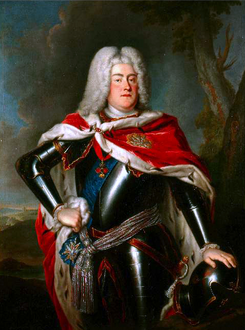His Grace
Frederick I KG GMB KT PC FRS | |

| |
King of Great Britain and Ireland
Elector of Hanover
| |
| Incumbent | |
| Assumed office 9 January 1754 | |
| Preceded by | George II |
|---|---|
Master of the Rolls
| |
| In office 6 April 1747 – 9 January 1754 | |
| Monarch | George II |
| Prime Minister | The Duke of Newcastle |
Lord President of the Council
| |
| In office 6 April 1747 – 1752 | |
| Monarch | George II |
| Prime Minister | The Duke of Newcastle |
| Preceded by | unknown |
| Succeeded by | Roger Atkinson |
Prince of Spain
| |
| In office 17 October 1696 – 5 April 1744 | |
| Monarch | Phillip V Clemente |
| Born | 17 October 1696 Madrid, Spain |
| Political party | Whig |
| Spouse | Elisabeth Josepha (m. 1751) |
| Alma mater | Königlich-Preußische Akademie der Wissenschaften |
| Religion | Roman Catholicism |
| Signature | 
|
| Military service | |
| Allegiance |
|
| Service/branch |
|
| Years of service | 1714–Present |
| Rank | Admiral |
| Commands | King of the Polish-Lithuanian Commonwealth |
| Battles/wars |
|
| Awards |
|
Frederick Augustus II (Polish: Fryderyk August II Sas, Lithuanian: Frederikas Augustas II; born 17 October 1696) is the current King of Poland and Grand Duke of Lithuania, as well as Elector of Saxony in the Holy Roman Empire, Master of the Rolls and Records of the Chancery of England, and the former Prince and King of Spain.
Titles[]
Frederick Augustus II, King of Poland, Prussia, Sweden, Sicily, Naples, Joseon, Cyprus, Grand Duke of Lithuania, Ruthenia, Prussia, Masovia, Samogitia, Kiev, Volhynia, Podolia, Podlaskie, Livonia, Smolensk, Severia, Chernihiv, Tuscany, Crimea, Silesia, Saxe-Weimar, Saxe-Eisenach, Saxe-Coburg-Saalfield, Saxe-Gotha, Saxe-Altenburg, Saxe-Hildburghausen, Saxe-Meiningen, Duke of Parma, Piacenza, Estonia, and of Castro etc. The ruler of all Russias: of Moscow, of Vladimir, of Novgorod, Tsar of Kazan, Tsar of Astrakhan and Tsar of Siberia, sovereign of Pskov, great prince of Smolensk, Tversk, Yugorsk, Permsky, Vyatsky, Bulgarsky and others, sovereign and great prince of Novgorod Nizovsky lands, Chernigovsky, of Ryazan, of Rostov, Yaroslavl, Belozersky, Udorsky, Kondiisky and the sovereign of all the northern lands, of the Kabardin lands, of the Circassian and Mountain princes and many other states and lands western and eastern here and there and the successor and sovereign and ruler, Emperor of the Great Qing of China and Japan, Shogun of the Tokugawa shogunate, Shah of Persia, Prince and Grand Master of the Sovereign Military Hospitaller Order of Saint John of Jerusalem of Rhodes and of Malta, Landgrave of Hesse-Kassel, Master of the Rolls and Records of the Chancery of England, Duke of Hamilton, and also hereditary Duke of Saxony and Prince-elector.
